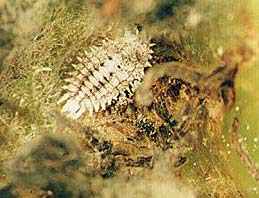Prevention of pepper and coffee mealy bugs
Mealybugs (scientific name: Pseudococcus sp ) are oval-shaped, about 4 mm long, 2-3 mm horizontal, the body is covered with white wax, around it there are long, white, foamy rays. The bigger the bed bug, the less it moves, moving from one place to another mainly thanks to symbiotic ants.
The aphids lay eggs in the cover with hundreds of eggs, outside with white wax covered. The young aphids have just hatched pink, but I don't have wax yet, my legs are quite developed and move to find a permanent place to live.
At the end of the rainy season, changing to the dry season, mealybugs grow gradually with the density, which is a dangerous pest to pepper and coffee trees, making the plants stunted, debilitating, badly damaged, can make the garden fade and death.
Harmful mealybug by:
- Concentrated into clusters of clinging to young tops, petioles, cotton buds, fruit bunches, branches or lower leaves, plastic injection to make leaves and fruits withered and dried. After aphid period, there are often black soot fungi growing on waste produced by bed bugs, blackening the pods and leaves, obstructing the plants' photosynthesis ability.

Pseudococcus - Pseudococcus sp
(Photo: hortnet.co.nz)
- Aphids also crawl to the ground to attract fluid from the stem and root roots. When aphids damage the roots a long time, they symbiotic with the Bornetina fungus in the soil to form large gray, rough surface areas around the roots, inside a bunch of bugs of all ages. the root surface has peeled off the shell to suck. The species of nematodes and fungi also follow the infestation wounds causing more serious harm. When the roots are badly damaged, the leaves are yellow and then wither and die because the broken root system is no longer able to absorb water and nutrients for the plants.
To prevent mealybugs should:
- Pruning branches of pests, old branches, branches that are located in the foliage to clear the garden.
- Regularly clean up garbage grass, leafy leaves around the root to break down the shelter of ants.
- Using a powerful spray pump with water spray on the place where there are many bugs that wash away less aphids, and create humidity on the trees to reduce the density of aphids.
- Regularly check every 10 days to detect the appearance of mealybugs on leaves, branches, fruit bunches, stems, and the body bordering the ground and roots in the soil. If you find that aphids even at low density must also eradicate immediately because mealybugs spawn very quickly.
- Except mealybugs on leaves and bunches of fruits: spray carefully with wet plants, spray 2 times 7-10 days apart to kill the newly hatched bugs.
-
Nurelle D 25 / 2.5EC, Oncol 20EC: 25-30 ml / bottle of 8 liters
-
Cori 23EC: 20 ml / bottle of 8 liters
-
Mospilan 3EC: 15 ml / bottle of 8 liters
-
Elsan 50EC: 30 ml / bottle of 8 liters
-
Applaud 10WP: 20-30 g / bottle 8 liters or Applaud 25SC: 8-12 m / bottle 8 liters
-
Citrole mineral oil 96.3EC: 40 ml / bottle of 8 liters
- Except for rooted mealybug:
+ Oncol 20EC: Mix 50 ml / 10 liters of water, water in the root zone 4-8 liters of solution for one root depending on the size of the plant. If the soil is dry, water it a day before watering it so that the soil has enough moisture to make it easy to diffuse it to the root area of the mealybug.
+ Lorsban 15G: cultivate around 10 cm deep in the root, sprinkle with 20-30 g / root, then cover the soil and water the plants.
- The secret to destroy bed bugs without chemicals
- Preventing stomach cancer from coffee
- Raising puberty of the pepper species: When I was young, it was very beautiful, growing up ugly and turning on my brain
- 10 facts about coffee
- How to make a perfect cup of coffee?
- Taste of pepper 13,000 years
- Using probiotics in pepper cultivation
- Around the world with 31 types of coffee
- Why are only some places growing the best coffee in the world?
- Applying technology in Mercedes cars, people have created the best coffee filter in the world
- Farmers successfully invented a clean infrared dryer
- The cold warning specialist of 'bug kissing' infects 300,000 people
 'Barefoot engineer' invents a pipeless pump
'Barefoot engineer' invents a pipeless pump Process of handling dead pigs due to disease
Process of handling dead pigs due to disease Radiometer
Radiometer Warp Engine: Technology brings us closer to the speed of light
Warp Engine: Technology brings us closer to the speed of light